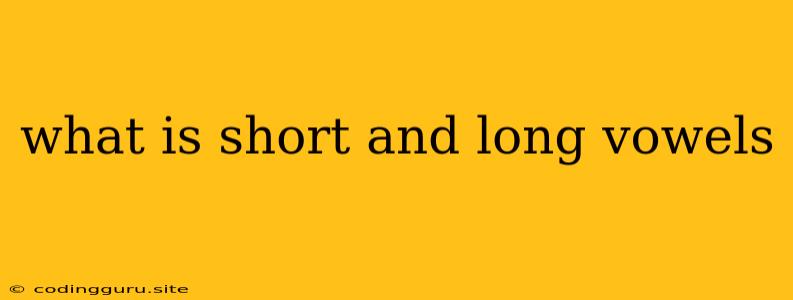What Are Short and Long Vowels?
Have you ever wondered why the word "cat" sounds different from the word "cake"? While both words use the same letter "a," they sound different! This is because of short and long vowels. Understanding these vowel sounds is crucial for anyone learning to read and write in English.
Vowels are sounds made by keeping your mouth open and letting air flow freely out. Unlike consonants, where your tongue and teeth block the airflow, vowels are created with an open, unimpeded path.
What Makes a Vowel Short or Long?
The length of a vowel sound determines whether it's considered short or long. Let's break it down:
- Short vowels are quick and sharp sounds. Think of them as saying the vowel sound briefly and abruptly.
- Long vowels are drawn out sounds, they are held for a longer duration, like a gentle and sustained breath.
Examples of Short and Long Vowels
Here are some common examples of short and long vowel sounds:
| Short Vowel | Example Word | Long Vowel | Example Word |
|---|---|---|---|
| a as in cat | cat, hat, man | a as in cake | cake, name, late |
| e as in bed | bed, met, ten | e as in bee | bee, see, me |
| i as in big | big, sit, fin | i as in bike | bike, time, lie |
| o as in hot | hot, dot, not | o as in go | go, no, home |
| u as in cup | cup, fun, sun | u as in cute | cute, music, blue |
How to Identify Short and Long Vowels
- Look for vowel digraphs: Digraphs are two letters that combine to make a single sound. Often, vowel digraphs represent a long vowel sound. Examples include "ai" (rain), "ee" (tree), "oa" (boat), "ie" (pie), and "ue" (blue).
- Check the ending of the word: Words ending in "e" often have a long vowel sound. This is because the final "e" is silent, making the previous vowel sound longer. For example, "bake" (long "a") versus "bat" (short "a").
- Listen carefully: Pay attention to the sounds of words, and practice saying them aloud. Focus on the duration of the vowel sound.
Importance of Understanding Short and Long Vowels
Knowing the difference between short and long vowels is essential for several reasons:
- Accurate pronunciation: Correct pronunciation is crucial for clear communication. Mispronouncing vowel sounds can lead to misinterpretations.
- Improved reading skills: Understanding vowel sounds helps to decode unfamiliar words.
- Stronger writing skills: Knowing how to represent vowel sounds accurately in writing is crucial for effective written communication.
Tips for Learning Short and Long Vowels
- Use flashcards: Create flashcards with examples of words containing short and long vowels. Practice saying the words aloud and focusing on the different vowel sounds.
- Read aloud: Choose age-appropriate books and read aloud with your child. Point out examples of short and long vowels, and encourage them to listen carefully.
- Play vowel games: Many fun and engaging vowel games are available online and in educational resources. These games can make learning short and long vowels enjoyable and interactive.
- Use mnemonics: Mnemonics are memory devices that can help you remember information. For example, you could use the mnemonic "CAT" to remember the short "a" sound, as in "cat."
Conclusion
Understanding the difference between short and long vowels is crucial for mastering English language skills. By practicing vowel sounds, exploring vowel digraphs, and employing effective learning strategies, you can develop a strong foundation in phonics and improve your reading and writing abilities.
